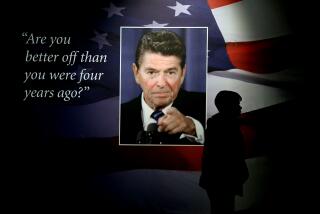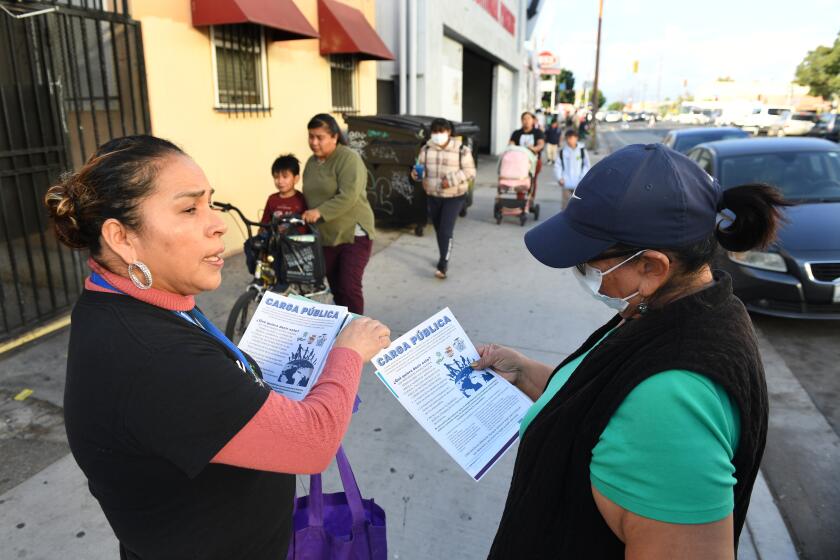COLUMN RIGHT/ BENJAMIN ZYCHER : Even the Poor Profited in the Reagan Years : Liberals angling for Clinton largess are denying the record of Americans’ gains in the ‘80s.
- Share via
That Ronald Reagan is responsible for the problems of the inner cities is an argument now quite popular among the interest groups benefiting from federal spending programs. Unfortunately, this trendy notion must confront a large body of inconvenient facts easily available in the historical record.
The Reagan Administration emphasized the fight against inflation rather than efforts for full employment, thus exacerbating poverty and joblessness. Wrong. The Reagan Presidency was accompanied by both an employment expansion of more than 18 million and a reduction in inflation unprecedented in U.S. history. Notwithstanding endless repetition, there exists no basis in economic analysis for an assumed trade-off between inflation and unemployment; the empirical experience is quite to the contrary. The 1970s brought sharp increases in both inflation and unemployment--remember stagflation?
The failure to promote full employment imposed heaviest losses upon minority youths. Wrong again. The unemployment rate for black teens fell from 38.5% in 1980 to 31.1% in 1990; the respective figures for white teens were 15.5% and 13.4%; thus, the proportionate decline was far greater for black teens than for white teens. That outcome stemmed largely from the refusal of Ronald Reagan to approve increases in the federal minimum wage, a policy designed ostensibly to increase the wages of low-skilled workers, but which in fact is designed to subsidize the middle class at the expense of the poor by making many low-skilled workers too expensive to hire.
The rich got richer and the poor got poorer. Very wrong. Average real family income grew by well over 15% from 1982 to 1989; for the bottom fifth of the income distribution, the figure was almost 12%. More important was the dramatic upward mobility among all classes during the 1980s: Families earning more than $50,000 (in 1990 dollars) went from less than 25% of all families in 1980 to 31% in 1990. The percentage of all families earning $15,000-$50,000 went down, as did the percentage of all families earning less than $15,000. The U.S. economy grew by more than one-third during the Reagan boom, and the assertion that all that additional income simply went to “the rich” is inconsistent with the evidence. The fact is that all groups--except young black males--grew wealthier during the 1980s.
The real hourly wages of lower-skilled workers increased during the Reagan boom; but those wages fell relative to those of workers with greater skills. But that pattern was a worldwide phenomenon beginning in the 1970s, as the increasingly international character of economic activity shifted relative wages in ways reflecting the international supply of lower-skilled and higher-skilled labor. Is Ronald Reagan responsible for that? Greater trade protectionism might reverse this realignment of relative wages, but also would reduce aggregate economic activity. Would such a perverse policy be salutary for the poor?
The problem of homelessness is the result of severe cuts for public housing programs during the Reagan Administration. Really, really wrong. The total number of public housing units available in the late 1980s was greater than at any time in history, and the number of new units brought on line during 1985-89 exceeded by more than 30% the number for any earlier five-year period. Those units had been authorized in earlier budgets, but the actual outlays came later.
More important, the Reagan Administration substituted a large housing voucher program in place of public housing, so that the poor no longer would be forced to live in crime- and drug-infested public housing ghettos. The substitution of vouchers for public housing means that construction is undertaken by the private sector, so that construction costs no longer show up in the federal budget. Thus has federal budget authority for “low-cost” housing declined sharply; but that is entirely beside the point.
Federal cuts in poverty programs, reflecting the decade of greed, wreaked havoc upon the poor. What cuts? And what charity! Federal spending on poverty programs in 1991 dollars increased from $140 billion in 1982 to $180 billion in 1991, a real annual growth rate of almost 3%. Total charitable contributions increased at the fastest rate in the postwar period, from $80 billion in 1982 to $126 billion in 1989, a real growth rate of almost 7%. In truth, the 1980s was the Decade of Giving.
It is not concern for the inner-city poor that drives this dishonesty; it is instead competition for federal budget dollars to be allocated by the new Clinton Administration. The latest player in the “blame Reagan” game is a group of RAND “senior analysts,” striving mightily through a media campaign to ingratiate itself with the new Administration, in the pursuit of new research contracts to replace those lost in the demise of the Cold War. Since the 1960s, the federal government has spent $2.5 trillion (that’s eleven zeros) on various urban and poverty programs, a growth pattern correlated almost perfectly with the rise of urban decay. And yet RAND’s “senior analysts” actually are willing to argue that more federal spending will yield net improvement. What explains such silliness? That’s easy: It’s Ronald Reagan’s fault.
More to Read
Get the L.A. Times Politics newsletter
Deeply reported insights into legislation, politics and policy from Sacramento, Washington and beyond. In your inbox twice per week.
You may occasionally receive promotional content from the Los Angeles Times.










